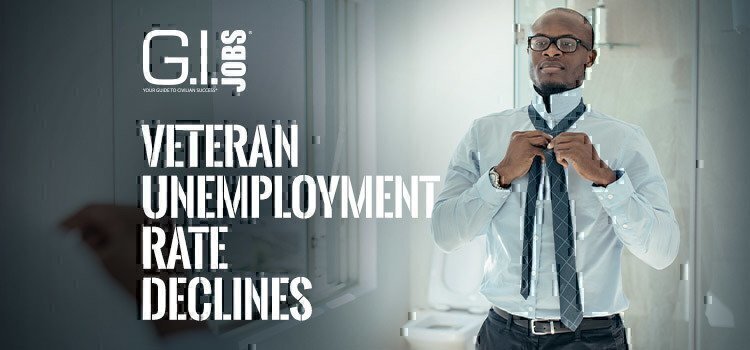The numbers continue to tell an amazing story regarding the unemployment rate for veterans, according to the most recent report from the U.S. Department of Labor. This rate has hit historic lows for veterans and non-veterans alike, as employers struggle to fill positions with the hottest labor market in almost 50 years.
Perhaps the most impressive news for the veteran community is that the veteran unemployment rate has surpassed the civilian rate’s decline for 13 months in a row.

Unemployment Stats Snapshot:
- May’s overall veteran unemployment of 2.7 percent marks a decrease from 3.4 percent reported in the same month last year.
- This number marks a slight increase compared to 2.3 percent in April.
- This rate beats the national unemployment rate of 3.6 percent.
- The rate for women held steady over 2018 at 2.7 percent.
- The men’s rate dipped to 2.7 percent from 3.5 in May of 2018.
So, it looks as if 2019 is on pace to be another record year. According to the U.S. Department of Labor’s 2018 report, last year’s unemployment rate for the latest generation of veterans dipped below 4 percent for the first time in history and represents an 18-year low for all veterans at 3.5 percent.
When the rate dips below four, we’ve reached what economists refer to as “full employment,” meaning anyone who wants to work is able to find a job. Other good news for veterans involves the labor participation rate, as reported in 2018. It reached more than 84%—that’s more than 20 percent higher than the non-veteran population.

Why This is a Big Deal
For those whose work centers on helping veterans find gainful employment after their service ends, this period in history is cause for serious rejoicing. Up until just a few years ago, the unemployment rate for Gulf War-era II veterans (in Iraq, Afghanistan, or both) hovered around 8.5 percent, while the national average was 68 percent lower. The U.S. Department of Labor’s report on 2018 veteran employment finds the unemployment rate for this specific segment of veterans is now around 5.9 percent.
How the tables have turned. As noted, the veteran unemployment rate now beats that of the general population. To keep the awesome low of 3.5 percent in perspective, the overall veteran unemployment rate peaked post-9/11 at nearly 10 percent.
What’s Changed
Well, obviously the economy. But it’s also likely more veterans are entering the workforce thanks to greatly improved programs that help them. These programs help people translate military experience into civilian work, present this experience more effectively on their résumé and during interviews, and learn how the workforce has changed in their absence and how to adapt.
In other words, resources abound, as we’ve strived to inform you about them, connect you with the right ones and keep you up-to-date with the latest and most-effective employment hacks right here at G.I. Jobs.

Room for Improvement
Statistics are great, especially when they reveal good things, but as we all know, they don’t tell the whole story. Underemployment is still a concern for veterans who have yet to find a position that fully utilizes their skillsets or provides satisfactory salary and advancement opportunities.
Several surveys of veterans also report many still encounter some level of bias during the application process. Even if they are hired, more than 40 percent leave within a year.
Perhaps part of the problem with retention relates to the number-one priority for many employers today: soft skills.
“An attitude where the mission comes first and interpersonal communication and effectiveness come second is not usually effective in a civilian environment where they tend to pay as much attention to how you do something as to what you do.”
“An attitude where the mission comes first and interpersonal communication and effectiveness come second is not usually effective in a civilian environment where they tend to pay as much attention to how you do something as to what you do,” says Emily King, author of “Field Tested: Recruiting, Managing and Retaining Veterans,” in a 2017 Marketplace article.
These concerns indicate more still needs to be done. Employers, with guidance from the military, could play a vital role in helping veteran hires adjust to the civilian workplace, especially as reports of PTSD and other mental issues are on the rise.
With more awareness of the challenges facing veterans as they re-enter the workforce, hopefully more training will be implemented to help them thrive both technically and interpersonally, to the benefit of their employers and their own personal well-being.
READ NEXT
7 Gym Essentials to Build an At-Home Gym
6 Veteran Influencers to Follow into 2019







